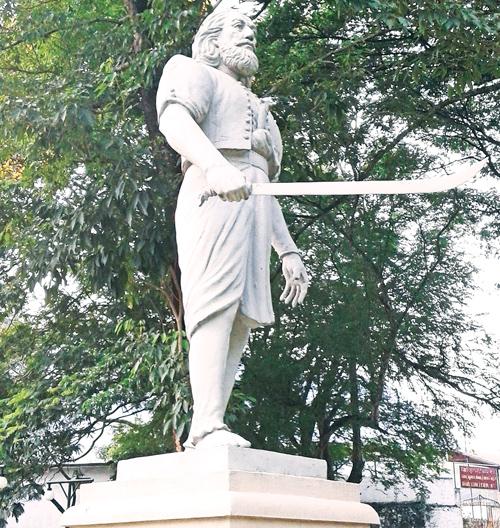
Monarawila Veera Keppetipola Dissawa was born in the Monarawila village in Udugoda Udasiya Pattuwa in North Matale. He was married to an aristocratic noble lady named Delwala Kumarihamy of Monarawila.
It is recorded that in addition to the post of Thamankaduwa Dissawa and Sath Korale in Matale. Keppetipola was appointed to the the post of Diyawadana Nilame, too, by King Rajadhi Rajasinghe.
He was known as Rajapaksha Wickramasekara Mudiyanse Ralahamy, but later he had added the name Bandaranayake Wickramasinghe, too, to his name (The Great Rebellion of up-country Vol 3 page 269). They were blessed with two sons and a daughter.
One of the sons played a leading role as a rebel chief performing very special service in the Uva Rebellion 1817-1818. In 1818 he was beheaded as he had admitted that he rose against the British Government. Keppetipola Dissawa was one of those who signed the Kandyan Convention in Sinhala - March 2, 1815, which handed over the whole administration of the Kandyan Kingdom to the British rulers.
Keppetipola developed a deep rooted grudge against the King because of the heinous execution of Ehelepola Kumarihamy and her children. However, he accepted the post of Disawa of Uva under the British regime as he thought it would be a great hindrance to his own activities if he did not hold a high ranking post in the government.
Later, when Keppetipola realised that Ehelepola’s aspirations were not fulfilled, he thought it was a disgrace to hold a post under the British.
Meanwhile, the peasants in Uva-Wellassa rose against the white rulers in a violent manner. The Kandyan chiefs too, were displeased by some actions of Ehelepola, and when they started to harass the rebels, they became more violent and aggressive. So the British Governor sent Keppetipola to subdue the rebels in Wellassa. To please the governor, and is it was not advisable to disobey the order, Keppetipola went to Wellassa thinking of driving away the rebels but things took a different turn. He joined the rebels and led the battle to free “Sinhale” from the white rulers. Under the leadership of Keppetipola the rebellion spread like wildfire throughout the hill country. On January 1, 1818 Governor Brownrigg met his high officials at the Royal Assembly Hall, Kandy (Magul Maduwa) and a list of names of traitors were announced, where Keppetipola’s name was mentioned as the first traitor.
Freedom fight
Doraisamy, who had been fighting to become the King of Kandy, later revealed that he was not from the Royal Family and had been a Buddhist monk who had given up robes. So the freedom fight against the British weakened as there was no proper person to become king.
The British Government issued a Proclamation on March 19, 1818 and declared that anyone who could capture Keppetipola, Madugalle and Pilamatalawe would be awarded 1,000 gold “Pagodi”. The three of them were hiding in a hamlet called “Parawahagama” near Kalawewa.
A tip off given by a Muslim trader to the white rulers, Colonel O’Neil was able to arrest Keppetipola. A letter dated October 29,1818 written by Colonel O’Neil to one of his friends named Frazer had described how Keppetipola behaved when the Colonel went to arrest him.
“When I entered the Walauwa Keppetipola came forward and shook hands with me and said, “I’m Keppetipola, I’m Keppetipola” Pilamatalawa was lying on a bed as he was sick. Madugalle with some others fled without getting caught. I got a letter written by Keppetipola to be sent to them to surrender and Keppetipola had said that they would surrender soon.”
This letter showed how Keppetipola behaved courageously when he was arrested.
One day, when Keppetipola visited the Dalada Maligawa he heard Ven. Degaldoruwe Thera reciting some verses sitting on the steps. These verses had motivated him to fight to free the country.
“Ane Kuhumbiyane
Thopatath Rajek in ne
Mokade Koran ne
Ape Karume Apata Wanne”
Rajek lebuno thin
Eda kiribath kan nan
Perahera Karan nan
Sadhu naden gigum den nam”
If and when we have a king, we’ll celebrate the event by partaking of milk rice and shout out loud “Sadhu” while going in procession.
Ven. Degaldoruwe Thera’s highly patriotic verses had impressed Keppetipola. The outstanding character he possessed was his earnest desire to protect and preserve the self-respect of the Sinhalese.
The letter he wrote to Governor Brownrigg when he returned the arms and ammunition to the English soldiers, which Keppetipola had taken to subdue the Uva rebels:
“Sir, do not think that I’m one who shirks responsibilities. It is a downright shame to use your gunpowder and guns to kill my native people and a disrespect to my Sinhala behaviour, so please take them back”.
A trial was held by Court Martial, presided over by a Lieutenant Colonel on November 13, 1818, and Keppetipola was condemned to be beheaded on November 26, 1818 at Bogambara. He first worshipped the Tooth Relic and sacrificed his life as a hero for the sake of his country, religion and people.
If the freedom struggle launched by Keppetipola had not weakened he would have definitely been an incomparable hero of Sri Lanka.
The British Government issued a gazette notification, which had mentioned the death of Keppetipola as follows.
“Throughout the whole period he behaved calm like a hero. Keppetipola Dissawa became a target to the executioner’s sword with firm belief that he was a great person who had performed an invaluable task”. (The Notes from Government Archives Department).
It was recorded that the executioner could not chop off Keppetipola’s head with one blow. The sword slipped, as this giant of a man had a strong neck and an extraordinarily large neck and a head. It was the second blow that completely separated the head from the body. Later his head was taken to the museum in Edinburgh and was returned to Sri Lanka, when Keppetipola’s great grandson Upali Keppetipola made a request from Queen Elizabeth 11. Now Keppetipola’s skull is interred in the Maha Maluwa, Kandy.
